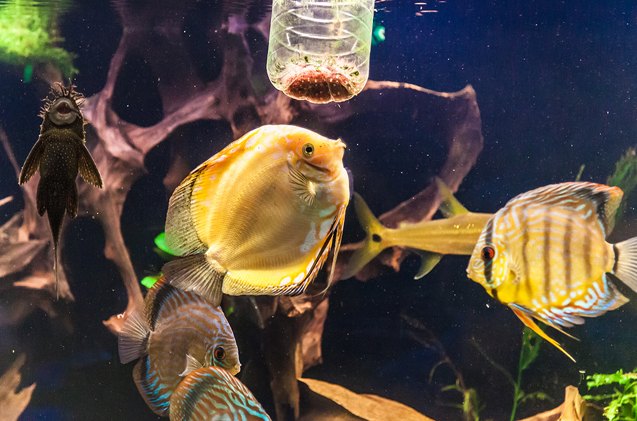Pros and Cons of Feeding Your Fish Live Food

When it comes to keeping your aquarium fish healthy, feeding them a high-quality diet is incredibly important. If your aquarium fish don’t get the nutrients they need, they will fail to thrive – they may also develop nutritional deficiencies. Live food is one of the best types of food for aquarium fish but it does come with challenges.
Types of Live Food
Before learning about the pros and cons of live food for aquarium fish you should learn the basics about this type of food. One of the most popular choices in live food for aquarium fish is brine shrimp because they are high in protein and they can be raised at home. Daphnia, also known as water fleas, are another popular choice, especially for newly hatched fry, because they are tiny. For newly hatched fry, infusoria (microscopic protozoans) are also a great option. Various worms like mealworms, bloodworms, and micro-worms are good for aquarium fish because they provide protein as well as fat. For larger fish with carnivorous appetites, even live fish like guppies and goldfish can be offered.
Related: The Truth About The 1 Inch Per Gallon Rule
Benefits of Live Food for Fish
The main benefit associated with live foods for aquarium fish is their nutritional content. Live foods are rich in nutrients because they have not been processed like commercial fish foods. Most live foods are high in protein which makes them healthy for aquarium fish – they are also good for conditioning fish before breeding. Another benefit of live foods is that they can be gut-loaded to increase their nutritional value. Gut-loading is simply the process of feeding the insects or feeder fish healthy foods that will then be passed on to your fish when they eat the live foods. It is also worth noting that live foods will not break down and decompose like commercial flake foods, and many fish find live foods to be more palatable than commercial foods. In fact, live-caught saltwater fish often do not accept anything but live foods in captivity because that is what they are used to eating in the wild.
Related: How to Properly Acclimate New Fish in the Aquarium
Downsides of Live Food for Fish
While live foods for aquarium fish are loaded with nutrients, there are some challenges and drawbacks to consider. For one thing, live foods can be much more expensive than commercial fish foods. It is, however, possible to save money by raising your own live foods at home. Another challenge associated with live foods is that they do not have a long shelf-life – you can’t expect to keep live foods for weeks or months at a time like you can with flake foods and pellets. Live foods also carry the potential to transmit diseases to your fish if they are cultivated from a polluted or contaminated environment – this is particularly common with tubifex worms. If the live foods carry some kind of harmful pathogen, it will be passed on to your fish when they eat the food.
As is true for all kinds of aquarium fish food, live food comes with its own unique set of pros and cons. It is up to you to decide whether live food is the right choice for your fish and, if it is, to determine which kinds of live foods to offer. Remember, different species of fish have different nutritional needs so keep the specific needs of your fish in mind when selecting a type of food.

Kate Barrington is the loving owner of two cats (Bagel and Munchkin) and a noisy herd of guinea pigs. Having grown up with golden retrievers, Kate has a great deal of experience with dogs but labels herself a lover of all pets. Having received a Bachelor's degree in English, Kate has combined her love for pets and her passion for writing to create her own freelance writing business, specializing in the pet niche.
More by Kate Barrington























